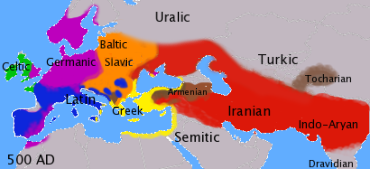
Word of the Day: Garrulous
Paul Schleifer
February 26 2018
Word of the Day: Garrulous
Garrulous means “excessively talkative in a rambling, roundabout manner, especially about trivial matters,” according to dictionary.com. Synonyms include prating, babbling, verbose, loquacious, and prolix, among others. In fact, looking at the list, one might wonder why we have so many words in English to describe someone who talks more than they should (BTW, I am using the singular “they” intentionally—feel free to write me at pschleifer@swu.edu to ask me why).
According to etymonline.com, the word comes into the language in the second decade of the 17th century, so it might very well be one of those “ink horn” terms I talked about before. It is “from Latin garrulus ‘talkative, chattering,’ from garrire ‘to chatter,’ from PIE root *gar– ‘to call, cry,’ of imitative origin (compare Greek gerys ‘voice, sound,’ Ossetic zar ‘song,’ Welsh garm, Old Irish gairm ‘noise, cry’).”
Let me explain. PIE stands for Proto-Indo-European, a reconstructed (hence proto) language from which the Indo-European family of language derives. Reconstructed? Well, yes, because there are no extant examples of Indo-European. Estimates are that the Indo-Europeans were a tribe speaking this single language sometime between 4500 BCE and 2500 BCE, so they could have had writing (we have some clay pieces that date from 5500-5300 BCE that contain script from other languages), but no evidence of Indo-European writing has yet been found.
The Kurgan hypothesis is that the Indo-Europeans lived on the steppes of Eastern Europe, specifically The Pontic–Caspian steppe, north of the Black Sea. The explanations underlying the Kurgan hypothesis rely on the words of the IE language—specifically types of terrain, plant life, food, and other basics of life. These people then spread out from their homeland in a variety of directions. As the descendants of the Kurgans lived out their lives, the language they spoke gradually changed, but it changed differently in different regions. Thus the Romance languages, the ones based on Latin, like Spanish, French, Romanian, and Italian, are related to the Germanic languages, the ones based on proto-Germanic, like German, Swedish, Frisian, and English, which are related to Sanskrit and Urdu, which are related to the Slavic languages, which are related to the Celtic languages….
As for “Ossetic,”
From deep Antiquity (since the 7th–8th centuries BC), the languages of the Iranian group were distributed in a vast territory including present-day Iran (Persia), Central Asia, Eastern Europe and the Caucasus. Ossetian is the sole survivor of the branch of Iranian languages known as Scythian. The Scythian group included numerous tribes, known in ancient sources as the Scythians, Massagetae, Saka, Sarmatians, Alans and Roxolans.
I think it’s also interesting that scholars have determined the PIE root to be “of imitative origin.” In other words, like yesterday’s “jabber,” the origin of “garrulous” is echoic. Recall that echoic means more or less the same thing as onomatopoeia.
If you managed to get all the way through this post, you may have decided that I can, at times, be garrulous, unless you think linguistics is not at all trivial.
The image is a map of the Indo-European family of languages as it existed around the year 500 CE. The surrounding languages, the ones all the same gray color, are other language families.